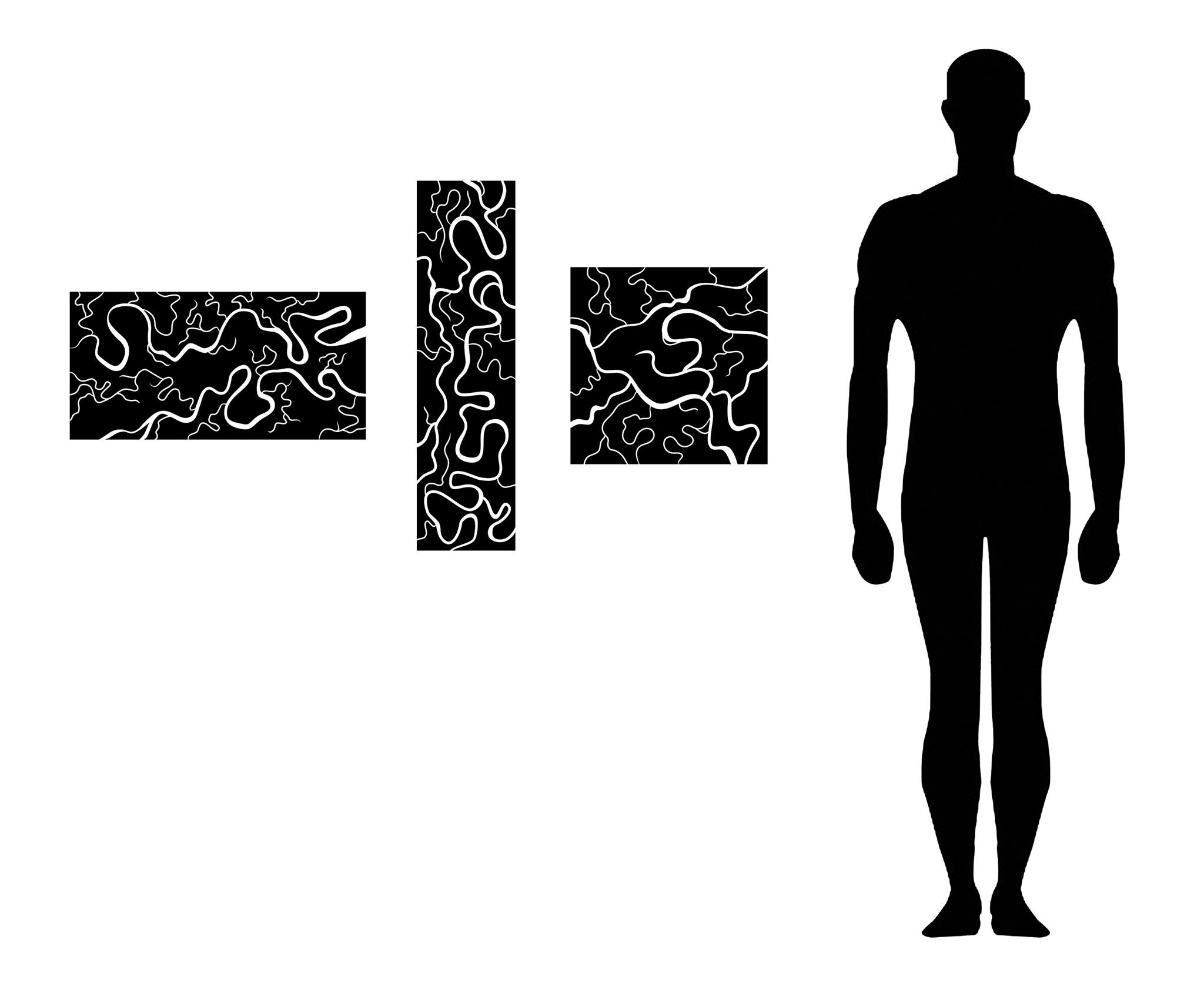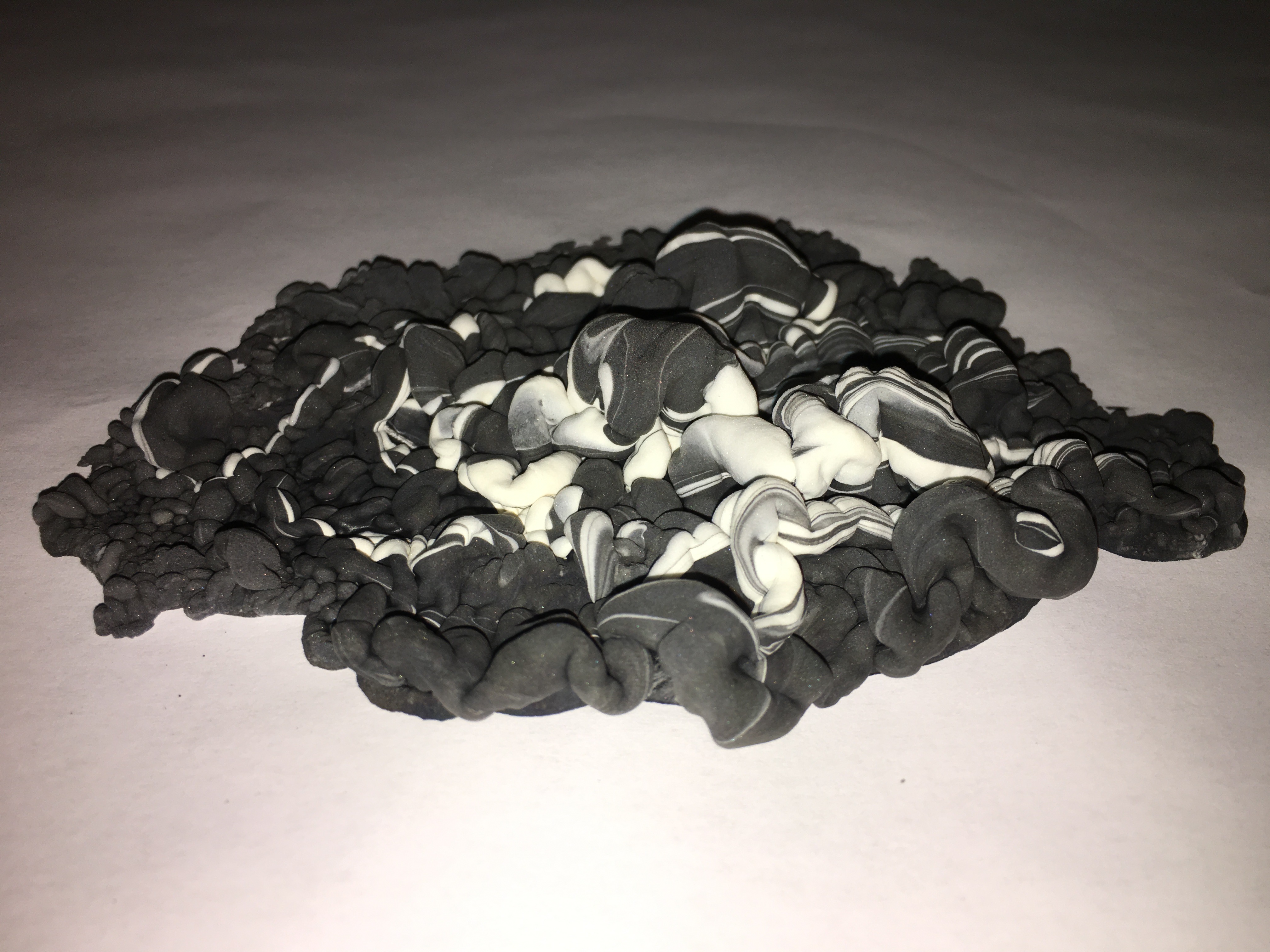Platinwald
Platinwald is a sound-producing installation enganging with tactility through interaction. Using materials not seemingly paired with technology, the piece challenges the notion of existence through the relationship of physicality and the juxtaposition of the intangible aural experience which unfolds before the explorer.
Created by: Thalia Agroti
Introduction
Platinwald is about being lost, about not knowing where one belongs in both a topological and existential sense.
The work endeavours to promote an alternative to the escapism most often achieved within virtual systems. Instead, through its playful environment, the installation aims to focus attention on embracing the fleeting moment spent in the space rather than questioning further. While tracing the terrain of embroidery inspired by aerial views of streams, an intimate and ephemeral experience unravels, formed by touching and hearing. Much like wandering lost in thought through a forest, echoes of the vastness of nature reflect the process of interaction at it’s most exploratory, whether fuelled by instinct or simply curiosity.
Concept and background research
The title of the piece means platinum forest in German and is a play on the name of a Berlin-based district called Planterwald. The specific district’s pronunciation has always amused me when passing by with the train upon frequent visits. While I don’t nationally originate nor does the location pose a reference in relation to the project, it is surely a city in which I personally feel a sense of belonging. The concept does not propose a focus on works that engage with topology for the reason that in Platinwald’s case it is much more an imaginary and personal bubble which becomes present through the interaction with the material and in embracing the sounds. In addition, the design of the embroidery which was largely inspired by aerial landscape shots of river streams and cracked ice, insinuates an abstracted and distant perspective or observational view of the world from above as a whole. For this reason, I chose to include a very simple quote or poem ‘’Stroke, Trace, Embrace’’ as a nudge or prompt for interaction, without giving away detailed instructions like a map would do. This was also done to mimic the feeling of being lost, so that one would have to ‘’find’’ the triggers on their own and not think too much about what the result actually is.
Where I did want to focus on though, was the use of materials which are not often paired with technology and even more so in the making of instruments, at least throughout my practice. While I don’t think of the shapes as objects separate from each other, they do have slight sound character differences between them. Starting with the horizontal rectangle, it includes a fluctuating drone and an ice-cracking effect, in which case this represents a view point of looking at ahead at an unfamiliar horizon. The vertical panel displayed in the middle, has the most ambient of sounds, one with a much brighter tone and one with droplet effects including a voice which slowly emerges, this panel represents a sort of epiphany/enlightenment or simply calmness and relief. Lastly, the square, has a variety of three sounds which are mostly compact in the sense that their melody does not fluctuate throughout their duration, apart from one which is a sound effect with a sharp characteristic.
Technical & Design
The physical aspect of the work is made up of three double-sided geometric shapes of wooly fabric. The front surface’s design is digitally embroidered with platinum thread. The larger and thickest of streams have manually sewn within them a line of conductive thread which is connected to a single core wire hidden between the two sides of the fabric. The reason of using normal thread for the main design was to be sure that the individual conductive threads would not overlap, as well as having more control of which areas to use as triggers. The finished soft sculptures are finally attached to a wooden frame in order to have a more solid surface to touch against. Ideally the fabrics were going to hang on their own, but this proved problematic and somewhat aesthetically unfinished.
The wirring leads up to a Touchboard microcontroller which is an all-in-one alternative to using an Arduino with an MPR121 chip which is what essentially allows for capacitive touch to occur. Programmed in Arduino IDE, the Touchboard is mapped to communicate with Logic Pro in order to receive midi data. While the Touchboard normally has an integrated SD card slot which accounts for sounds to easily be stored on, this option has its limitations since it does not allow for multiple sounds to be played simultaneously due to the structure of the board. To move past this, I created a customised virtual midi instrument where each piano key represented one of the sounds. Since normally the instrument is using notes, the keys had to be translated into midi numbers in order to be mapped correctly within the code. The majority of sounds are produced to fade in and out and last about a minute, with the exception of a sound-effect located on the square which once is activated will play sparingly for several more minutes but it is also the only sound which can be re-triggered. Each individual sound was created to play in harmony with all other sounds at whichever point it comes in as they eventually blend together until they all fade out when left alone.
Future development
The initial vision for this project was that I would have filled a space with longer fabric strips that lead up to the ceiling and hang in mid-space almost reaching the floor. This would ideally create an actual forest if you will, through which the triggering of sounds would not happen to such duration but rather would be affected by the movement while passing through and then further modulated if a person chose to stroke or pull on the strip or specific conductive material upon it. While the original idea is most likely possible, as it is often the case, matters of time and budget got in the way but should there be another chance and an appropriate space I would surely go into developing it better, stronger and with expanded technical complexity.
Lastly, I would like to explore more experimental ways of using the thread than just through embroidery, as well other conductive materials. I played around by creating a conductive puff during the experimentation process and it didn't work as well as I hoped, but I am very interested in creating more intricate and strange textures in the future as well as larger scale and more immersive installations.
Self evaluation
Since sound is my main element, the tone and methods which I’ve normally produced with have been mostly through improvisations with circuit-bent or DIY instruments and more often than not, had a noisy or harsh flare. For this project, I wanted to challenge myself by producing sounds digitally, which may sound easier to some but for me it did not come as intrinsically and as comfortably as I would I normally feel during improvisation. In addition, I wanted to step into a different tonal vibe. While I’ve kept the inclusion of some drone or darker undertones, I’ve moved away from beats or distinguishable patterns as well as intense sounds. In order to keep true to the concept as well as to get out of my comfort zone, I engaged with more sensitive, ambient and atmospheric sounds, including some sound effects either found from nature or made artificially. I enjoyed that I had to dig even deeper into Logic Pro for building my own virtual instrument for things like midi interaction with other software which I’m sure is something I’ll be using more of in the future.
However, what was most exciting, was working with fabric, thread and wood materials which I hadn’t explored before and the hands on process of making those was definetely a part which I feel good about as well as in terms of results and finish. The area(s) which I would say could use an upgrade, much like what is mentioned in the future development section, is that while there was ambition for more complexity overal, the inevitable simplification down the road did not only have an affect on the physical outlook of the piece but also in stripping down the coding or hardware much more than I’d like to feel proud for. In addition, the choice of allowing the sounds to unfold once activated with no way of affecting it further was a conscious decision and was predicted to work fine in terms of interaction if one or two people were in the room which was ideal, but it was rather confusing when a lot more people moved about and tried touching because they assumed the piece was not responding to them since the sounds were already playing.
References & Inspiration
http://www.electronics.dit.ie/staff/tscarff/Music_technology/midi/midi_note_numbers_for_octaves.htm
http://www.instructables.com/id/How-to-Use-Conductive-Thread-in-a-Sewing-Machine/
http://www.instructables.com/id/Conductive-Thread-Touch-Sensor/
https://www.wired.com/2012/07/knit-scarves-power-a-piano/
http://www.francescaperona.com/portfolio/2113/
https://www.youtube.com/watch?v=oRIP_i-TC5o
http://www.xxx-clairewilliams-xxx.com/



































































